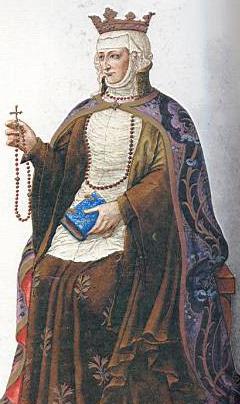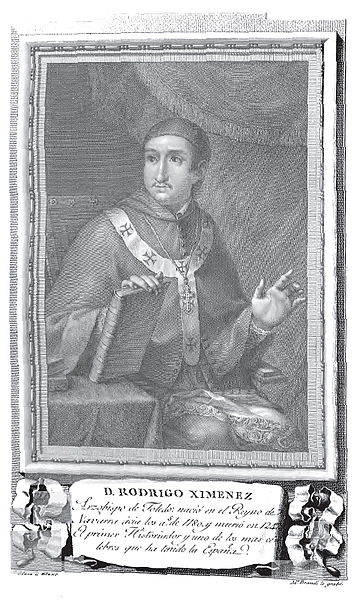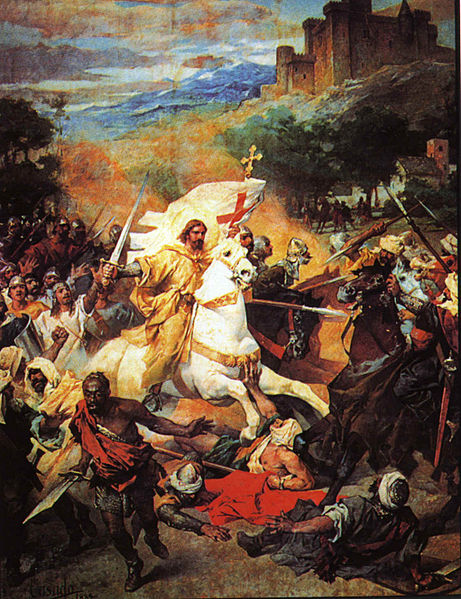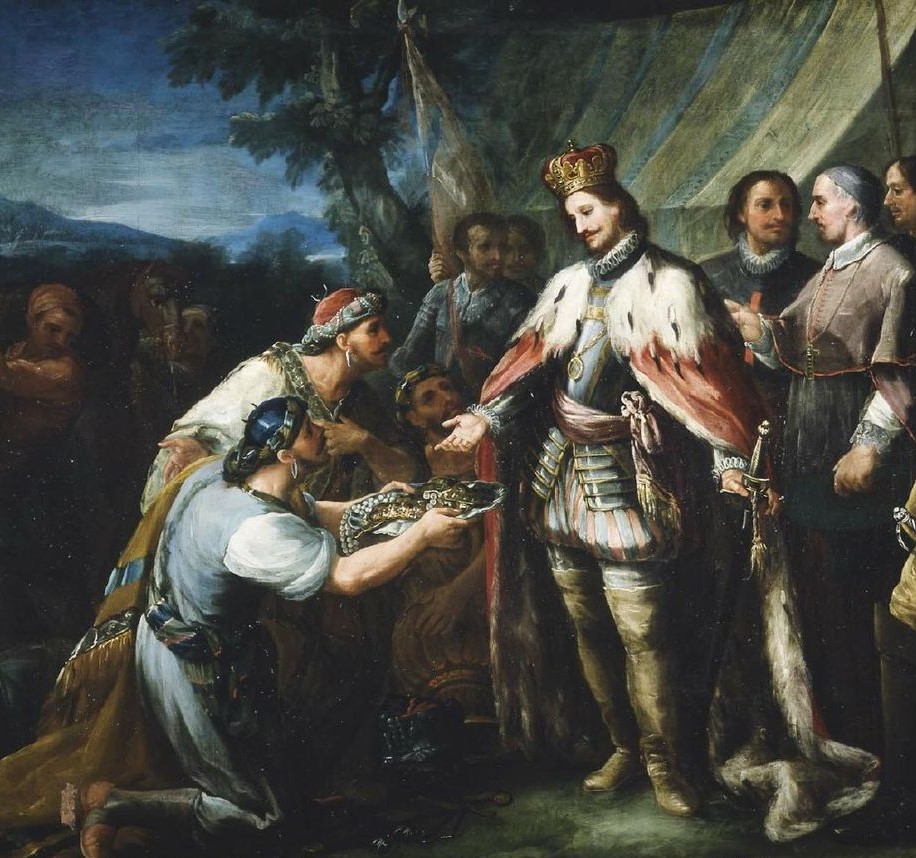By Jeremias Wells
Saint Ferdinand III of Castile – Part I
King Alfonso VIII of Castile, the great leader of Las Navas de Tolosa, left two daughters who became queen mothers of two young kings, both of whom developed into illustrious warriors, crusaders, and saints. Because Alfonso’s two sons died in their youth, one from illness in 1211 and the other from a tragic accident in 1217, their sister, Berenguela, rose to the throne of Castile.
However, realizing that it was improper for a woman to occupy the throne in this most chivalrous state, she renounced her kingdom to her first born son, Ferdinand III, then only eighteen. Blanche, the second daughter, married King Louis VIII of France who, after an exhausting campaign against the remnant of the Albigensian rebellion, died in 1226. Since Louis, his oldest boy, was only twelve at the time, the Queen acted as regent while the young King slowly assumed the control of government during the next two decades. In a remarkable display of piety, both Kings saw the necessity of renouncing any earthly comfort to further the interests of Christendom and their own realms.
Youth of Ferdinand of Castile
Because the future King’s parents were related within the forbidden degree of consanguinity — they were second cousins — Pope Innocent III insisted they separate and, as a result, young Ferdinand was brought up at the court of his grandfather. The serenity of the boy’s life was shattered when a terrible malady overtook him at the age of ten. Consumed by a high fever and horrible restlessness, the devout lad could not eat, sleep, or take any rest. When the poor child developed large repulsive sores which caused unrelieved pain, death seemed imminent. Dona Berenguela took him to a chapel of Our Lady where she prostrated herself on the cold tile floor in front of the main altar and prayed throughout the night. When her servants returned the following morning, they found the boy sleeping soundly. As a consequence of the miraculous cure, San Fernando from then on dedicated himself to the service of the Blessed Virgin.
In 1214, Alfonso VIII died, leaving the Kingdom of Castile to Berenguela’s adolescent brother Enrique (Henry) who, in turn, was entrusted to the regent Count Alvaro Nunez de Lara, a man noted for his ambition and avarice. More misery fell upon the family when Fernando’s father, King Alfonso IX, ordered his son — now fifteen — to be sent to his corrupt court in the Kingdom of Leon¹. Since the upright young man could find no alternative to his obligation of obeying his father’s command, he told his heartbroken mother, “Christ redeemed us not in the sweet arms of His Mother but on the hard arms of the Cross, and His knight will not serve Him in any other way,” and went off. For the first time in his life, he witnessed the degrading spectacle of immorality and found the things that he saw and heard deeply repulsive. What was more painful was that his father was one of the worst sinners. He realized that he must fight like a hero or be dragged into the mud like so many others, losing in the process an unrecoverable treasure: his innocence. During this period Fernando practiced the handling of weapons for long hours and rode great distances in cold, rainy weather to accustom his body to hardship.
Meanwhile, Count Alvaro was terrorizing Castile with cruelty and injustice. His ambitious plans were suddenly unraveled when young Enrique, while playing with some companions, was struck on the head by a roof tile and died a few days later. After cleverly escaping from his father’s clutches, the eighteen-year-old heir to the Castillian throne rode south to give support to his mother. However, she quickly yielded her rights to Fernando, who was proclaimed King of Castile. Once Alfonso realized he had been tricked, he, with encouragement from Alvaro, invaded Castile in order to drive his son from the throne. Fernando, now faced with a dilemma of either taking up the sword against his father, which greatly troubled his sensitive soul, or abandoning his responsibility to his subjects, brought an army into the field opposite his father’s.
That night he sent his wise counselor Archbishop Roderigo Ximenez de la Rada along with other bishops to plead with the Leonese King to act honorably and with justice. Realizing that even his own followers sympathized with the young saint, Alfonso agreed not to attack providing Fernando pay a large sum of money. When the bishops returned to Fernando’s tent that night to report on the successful negotiations, they found the young King in his private chapel praying with his arms in the form of a cross and with the back of his white tunic stained with blood. He had applied the discipline for the sins of his father. Although the two were reconciled as Kings, they never entered into a father and son relationship. Alfonso finished out his days fighting against the Moors with a contingent of Castilian troops. Shortly after the conclusion of peace, Berenguela arranged a marriage for Fernando with Beatrice of Swabia, a close relative of the ruling Hohenstaufen family in Germany and Sicily.
Fernando Renews The Reconquest
In 1224, with his internal political affairs resolved, the youthful Crusader turned his attention to the Reconquest, a military campaign that with a few short intervals occupied him for the rest of his life. Quesada, the first town to fall, was typical of the many that followed. The Castilians placed cloth-muffled ladders against the walls just before daylight. Fernando raced up a ladder, jumped on the wall first, and struck down an approaching guard with a firm gashing blow to his head. The other knights were just seconds behind. Shouting, “Santiago and Castile,” the Crusaders threw themselves into the fight to protect the life of their valiant King, who always seemed to be ahead of them. Slashing and cutting, they gained control of the wall and towers and opened the gates, allowing their army to rush in and capture the streets and squares. The first rays of the sun saw the town in Christian hands. On the highest tower, Fernando, covered with Moslem blood from head to toe, planted the Cross and, gazing at it lovingly, prayed: “Knowest that I do not seek my glory but thine; not the greatest of perishable kingdoms, but the kingship of Christ on earth.”
Throughout the next six years, Fernando raided central Andalusia, capturing most of the small towns, ravaging the countryside, collecting much booty. Only the three large, walled cities of Cordoba, Seville, and Jaen avoided capture because of their massive fortifications and large garrisons. King Alfonso of Leon died in 1230. As Fernando rode north to claim his father’s kingdom, he received shocking news. Although the mercurial King had earlier chosen his son as his heir in a formal session before Parliament with the Pope’s approval, he changed his mind and left Leon to two daughters from a previous marriage which was also annulled. Alfonso had reached from beyond the grave to injure his son one more time. Both the mother of the princesses, Dona Teresa², who had retired to a convent many years before, and Dona Berenguela traveled to Leon to prevent a bloody dynastic war since several ambitious noblemen saw an opportunity for riches and political gain. In a series of calm, recollected discussions, those two magnificent ladies realized that the only just and appropriate solution was for the two royal daughters to abdicate. Although it required a great sacrifice on their part, they followed their mother’s wise advice and were rewarded with a generous pension from Fernando. As the monarch rode back to the battlefield, he was now backed by the resources of the new, powerful Kingdom of Castile and Leon which, from that point on, remained unified.
During the 1230’s, the Christian rulers of Spain maintained continual pressure against the Mohammedans by pushing south along a broad front. West of the Gaudiana, the military orders of Calatrava and Santiago helped Portugal extend their southern boundaries. Just to the east of the river, Fernando’s brother, Alfonso de Molina, led a marauding army past Cordoba and Seville to Jerez where he won a stunning victory over superior numbers. Santiago (Saint James) was seen, even by the Moslems, on a white horse and with his sword drawn, leading a legion of knights. On the eastern front, another successful crusading King of the first rank, Jaime ( James) I of Aragon, who had previously captured the island of Majorca, forced the capitulation of Valencia, which in essence completed the Aragonese Reconquest.
Taken from Crusade July/August 2001, Pgs. 31-33
Stories on Honor, Chivalry, and the World of Nobility—no. 622
Notes:
- Ferdinand’s maternal grandfather, Alfonso VIII of Castile, and his father, Alphonso IX of Leon, were actually of the same generation. They were both grandchildren of Alphonso VI
- She is also canonized (feast, June 17) because of the holiness of her life after her separation from Alphonso IX.















